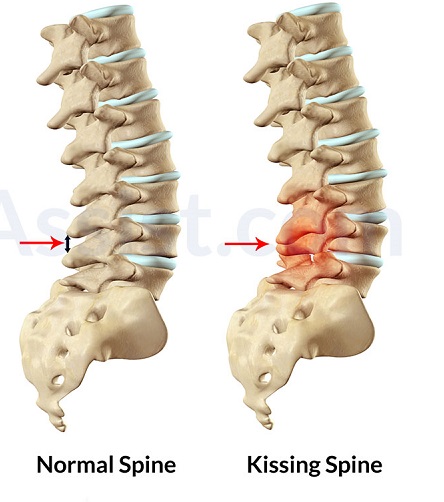A male, 70 years of age experiences serious episodes of low back pain for the past 10 years. The pain is accompanied with tenderness on palpation, in the mid-lumbar region. The patient explained that the pain becomes worse during extension movements while relieves during forward flexion. A CT scan and MRI was performed which showed that the L3 and L4 spine were facing each other, with the interspinous space filled with fluid, causing inflammation around the tissues. It turned out to be Baastrup's disease or kissing spine syndrome.
What Is Baastrup's Disease?
 Baastrup's disease is named after a radiologist, Christian Ingerslev Baastrup. This disease is also known as back pain syndrome. This condition is characterized by the changes in soft tissues between the adjacent spines. Baastrup's disease also has other names such as interspinous bursitis (ISB) on the interspinous region, which is an adventitious bursa appears because of the formation of a synovial articulation. This is why both of the terms, ISB and Baastrup's disease, are used interchangeably.
Baastrup's disease is named after a radiologist, Christian Ingerslev Baastrup. This disease is also known as back pain syndrome. This condition is characterized by the changes in soft tissues between the adjacent spines. Baastrup's disease also has other names such as interspinous bursitis (ISB) on the interspinous region, which is an adventitious bursa appears because of the formation of a synovial articulation. This is why both of the terms, ISB and Baastrup's disease, are used interchangeably.
Back pain is one of the characteristic symptoms of Baastrup's disease because of the close contact of spinous processes. The condition is most commonly found in lumbar and cervical region, and sometimes results in degeneration of spine.
Symptoms of Baastrup's Disease in Humans
Baastrup's disease or kissing spine syndrome is an acute condition of cervical or spinal region, resulting in severe back pain as discussed previously. This mechanical instability of spinal processes may produce other symptoms. Some of the characteristic symptoms of Baastrup's disease are:
- Patient feels pain in spinous processes.
- Patient will sometimes feel numbness due to involvement of nerves.
- Rotation movement is compromised because L4-L5 is most commonly affected.
- Hyperextension caused by swimming may worsen the condition.
Causes of Baastrup's Disease in Humans
The exact cause of this disease is still unknown. However the most commonly believed theory is that the space between discs is eliminated, causing disc degeneration and contact of adjacent spinous processes. Some potential triggers that may initiate the disease include:
- Spondylolisthesis
- Lordosis
- Incorrect or abnormal posture
- Accident spine injuries or trauma
- Obesity and over-weight
How to Diagnose Baastrup's Disease
Diagnosis of Baastrup's disease is done by various techniques. The following is the most commonly used diagnostic procedures.
1. Plain film and computed tomography (CT scan)
The results of plain film and CT scan can show close approximation of adjacent processes. Flattening, enlargement of spine can also be observed.
2. Magnetic resonance imaging (MRI)
Intespinous bursal fluid accumulation that causes bursitis is observed. Postero-central epidural cysts will show in MRI.
3. FDG-PET/CT scan
PET scan and CT scan give more appropriate results when inflammatory condition such as bursitis is present. MPR (multi planar reconstruction) is performed in case of a possible malignancy.
How to Treat Baastrup's Disease in Humans
Baastrup's disease can affect your daily life, bringing enormous pain. It should be treated and managed by the following methods.
1. Injections
Injections of corticosteroids are generally administered for relieving the pain.2 to 4 infiltrations are indicated in case of micro-trauma. The physician will ask you to avoid any lumbar spinal movements during the treatment protocols.
2. Surgery
If the patient do not responds to corticosteroid injections, then surgery is performed for partial or total excision of spine.
The surgery does not always provide satisfactory results. According to a latest research survey conducted on different patients of Baastrup's disease, investigators revealed that only 11 patients out of 64 were completely satisfied with the surgery, the remaining 53 had developed the pain again after some time. This may be because that the basic cause of this condition may differ from patient to patient. For example, Baastrup's disease pain caused by lumbar spondylosis is not relieved by surgery.
3. Physical Therapy Management
Physical therapy is considered as an important treatment protocol for Baastrup's disease as it helps in regaining the muscle flexibility and strength. Physical therapy also improves the neuromuscular damage caused by the disease.
Trough abdominal muscles strengthening, it helps in treating pain caused by lordosis. Muscle activity (such as gluteal muscle and abdominal muscle) can be increased in case of hyperlordosis. It also supports in regaining the lumbar position by relocating hip flexor muscles. Pilate exercise, a type of physical exercise,can improve the condition of hyperlodosis.
Watch the video to know how to deal with back pain with physical therapy:
